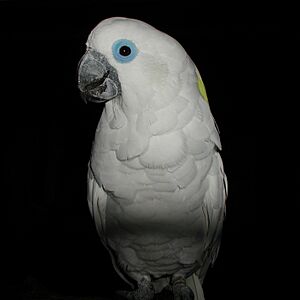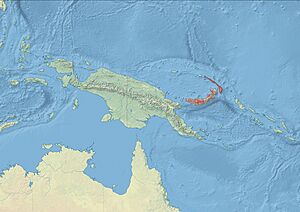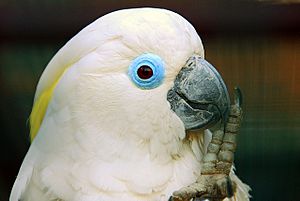Blue-eyed cockatoo facts for kids
Quick facts for kids Blue-eyed cockatoo |
|
|---|---|
 |
|
| At Walsrode Bird Park, Germany | |
| Conservation status | |
| Scientific classification | |
| Genus: |
Cacatua
|
| Species: |
ophthalmica
|
 |
|
| The Distribution of the blue-eyed cockatoo | |
The blue-eyed cockatoo (Cacatua ophthalmica) is a large, mostly white cockatoo. It grows to about 50 cm long. This bird has a special crest that can move up and down, a black beak, and a light blue ring of skin around each eye. This blue ring is how it got its name!
Like all cockatoos and many parrots, the blue-eyed cockatoo can hold things with one of its feet while standing on the other. This is a special skill that not many birds have. They use this skill to hold food and bring it to their beak.
Contents
What Does a Blue-Eyed Cockatoo Look Like?
The blue-eyed cockatoo is a big bird, about 50 cm tall. It's mostly white with a yellow and white crest that can stand up. It has a black beak, dark grey legs, and that famous light blue skin around its eyes.
Male and female blue-eyed cockatoos look very much alike. Sometimes, males have dark brown eyes and females have reddish-brown eyes. But this difference is very small and not always a sure way to tell them apart.
It's easy to mix up the blue-eyed cockatoo with the yellow-crested cockatoo and sulphur-crested cockatoo. However, the blue-eyed cockatoo has a rounder crest with more white on the front. Its blue eye-ring is also brighter. These birds live for about 50 years and become fully grown after 4 years.
Are They Good Pets?
Blue-eyed cockatoos can be wonderful pets, but they need a lot of care. Some people say they are the friendliest and most loving of all cockatoo types. They can learn to copy what their owners say and love to play. They might even lie on the backs of people they care about!
Because they are so smart and loving, these birds need a lot of attention. If they don't get enough interaction, they can become stressed. This stress might cause them to pull out their own feathers. So, it's important to spend lots of time with them to keep them happy and healthy.
What Do Blue-Eyed Cockatoos Eat?
The blue-eyed cockatoo mostly eats different kinds of seeds and nuts. They also enjoy berries and fruits. Sometimes, they will eat insects and their larvae (young insects).
Where Do Blue-Eyed Cockatoos Live?
The blue-eyed cockatoo lives only in the lowland forests of New Britain. This island is east of New Guinea. It's the only cockatoo found in the Bismarck Archipelago group of islands.
These forests include untouched forests, forests where some trees have been cut, and "gardened" forests. Gardened forests are areas tended by local people. In the 1960s, it was hard for scientists to find these birds. This was because the cockatoos would fly very high, sometimes 3,280 feet in the air, especially over the gardened forests.
They don't pick a specific type of tree for nesting. However, they are found more often in untouched forests than in gardened ones. Their nests are usually in very large trees, about 41 meters high. Scientists think blue-eyed cockatoos might move to different altitudes or areas depending on the season.
As of 2012, there were an estimated 10,000 to 15,000 blue-eyed cockatoos. Sadly, this number is going down.
Why Are Blue-Eyed Cockatoos in Danger?
In 2004, the blue-eyed cockatoo was thought to be a species of "least concern." This meant it wasn't in much danger. But scientists later realized it was becoming much rarer than they thought. So, in 2008, its status was changed to "vulnerable." This means it's now at risk of becoming endangered.
The biggest danger to these birds is the fast clearing of lowland forests. These forests are being cut down to make room for oil palm plantations. This destroys the places where the blue-eyed cockatoos build their nests. Losing their homes can make it harder for them to breed, which causes their population to shrink.
Illegal trade also puts pressure on these birds. People try to catch them to sell them as pets. The traps used to catch them can be very harmful, sometimes even using branches covered in glue. Unlike some other birds in these forests, the blue-eyed cockatoo seems to need untouched, dense forests to survive. While they can be seen in other forest areas, they are most common in the primary (untouched) forest regions.



